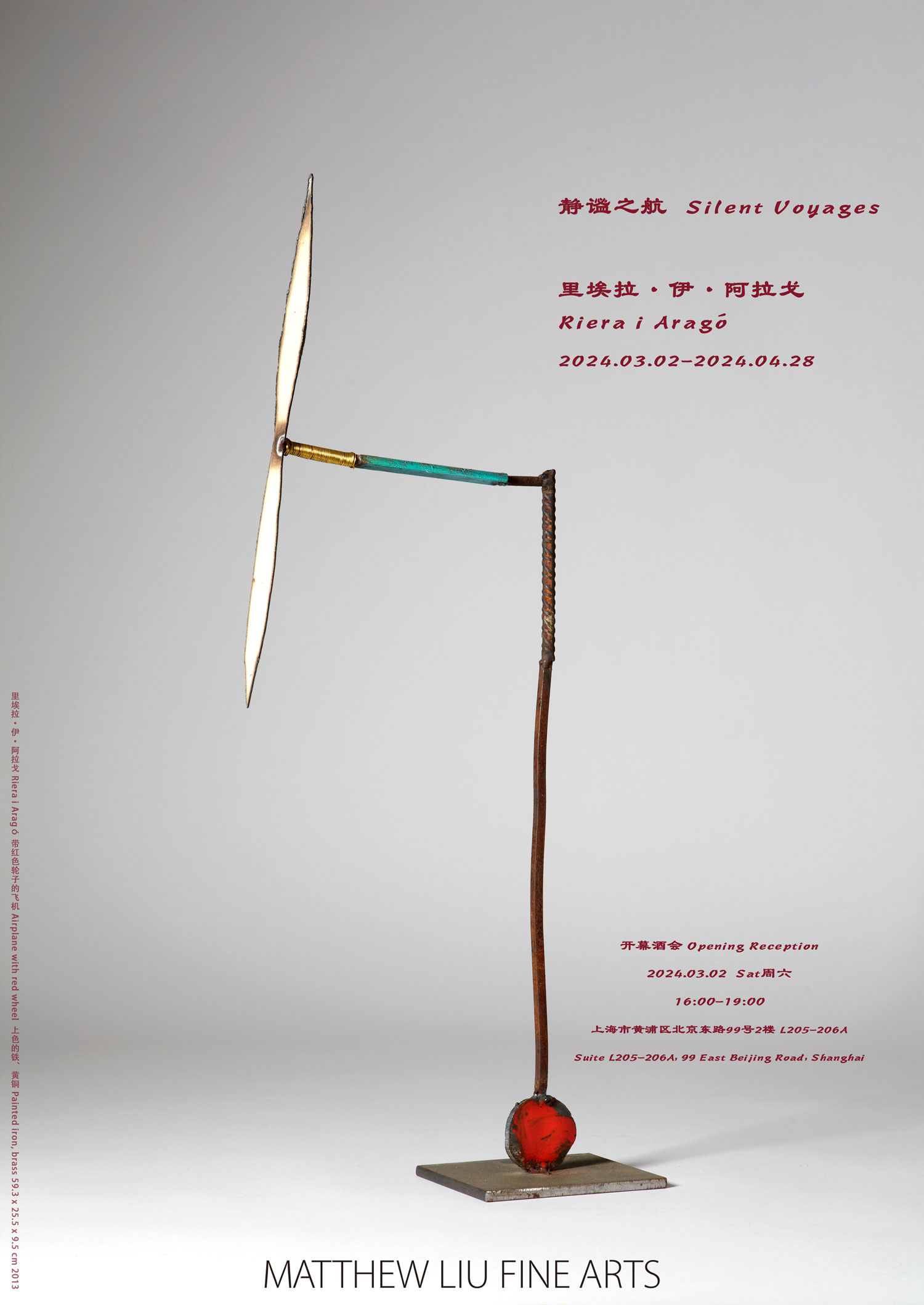展期 Period:
2024.3.2—2024.4.28
艺术家 Artist:
地点 Venue:
新闻稿 Press Release:
新年伊始之际,德玉堂画廊荣幸地呈现西班牙艺术家里埃拉·伊·阿拉戈(Riera i Aragó)的最新个展《静谧之航》。此展不仅是艺术家对自然与机械之间交织美学的深度探究,也展示了他对抽象艺术的创新精神和现代主义思想的独特诠释。艺术家通过雕塑和绘画,挑战视觉艺术的边界,揭示了人造物与自然形态之间的复杂对话,激发人们对于在科技迅疾发展的社会中,人与自然和谐共存的思考。在他的艺术创作中,机械结构不再只是工业产物,而是成了探索广泛意义上的自然、存在和创造力的媒介。
从1970年代初期开始,阿拉戈便致力于深海环境、机械和飞机等主题的探索,这些主题见证了他生活的轨迹。他独特的创作手法将自然风景元素融合于其作品中,也在此得到了体现。例如,他巧妙地将沙滩上的碎片和木材整合进青铜雕塑,或是将解体的船只铁片融入艺术作品中,这不仅彰显了他对形态和结构的关注,也展示了对材料特性——如质地、光泽和重量的多维探索。不同于奥拉维尔·埃利亚松(Olafur Eliasson)强调的人与环境的互动以及丽贝卡·霍恩(Rebecca Horn)侧重探讨的机械与人类情感,阿拉戈更着重于“形态”与“时空”的层叠交互,并通过作品讲述生命不断在时间洪流中进行冒险和重生的旅程。与未来主义(Futurism)和动态艺术(Kinetic Art)在探讨人机关系时的对比中,阿拉戈的作品揭示了一种超越机械功能性和自主性的视角。他的创作不仅仅是关于传输或航行的手段,而是一段关于“可能性”的预言叙事,此观点也体现在艺术家对悬浮状态和无重力平衡的深入探求。
本展汇集了阿拉戈近年来,特别是疫情期间的创作。聚焦于利用材料的独特性质和形态的革新,将钢、铁、铜、木材等传统材料与现代科技元素相融合,展现艺术家在材质、形态和空间布局上的新高度。首先,观众会在第一展区接触到艺术家对飞行器主题的研究,包括标志性的《飞机》(Avió)三联画和《埋地潜艇模型》(Model of Buried Submarine)雕塑等,这些作品将机械元素融入自然语境中,象征性地连接了“现实”与“想象”,为探索技术、艺术运动与人文精神的交织主题定下了基调;随着展览的深入,第二展区将被引导至探索飞行的“形态”与“抽象”,其中雕塑《金色飞机》(Golden Airplane)和墙上作品《三艘船I》(Three boats I)等深化了这一主题,展示了艺术家在铁和铜材料上的独到见解及飞行器在空间中的动态存在;在最后一个展区中,艺术家以岛屿、船只及潜艇系列绘画与雕塑深化了对“自然”与“技术”的讨论,为深海与空间探索的一次完整总结,启发对人与环境关系的深刻思考。
阿拉戈的创作既是反映科技发展对人类生活的影响,也是对“存在”本质的精细探讨。艺术家借助其对抽象主义的前卫视角和现代主义哲学核心的深刻洞见,挖掘出机械与自然之间的互动和平衡所蕴含的新哲学和美学意义。这种探索赋予了他作品独特的时代感和思想深度。通过独到的视觉语言和对材料的创新运用,他讲述了一段可见与不可见、机械与航行、艺术相互交融的故事。《静谧之航》标志着阿拉戈艺术探索的重要里程碑,邀请观众深入体验作品中值得细味反刍的深刻哲思和美学价值。阿拉戈的作品不仅是对科技进步与自然环境关系的反思,也是对生活、宇宙以及人类创造力无限可能性的颂歌。他的艺术创作不仅在西班牙及国际上广受好评,更在多个重要美术馆和博物馆展出,包括德国海布隆市政博物馆、法国亚尔梵谷基金会、西班牙巴塞罗那米罗基金会、比利时奥斯坦德现代艺术博物馆等。此外,他的作品也被多个重要机构永久收藏,如法国亚尔梵谷基金会、西班牙巴塞隆那市政厅、比利时西弗兰德省旅游局和芝加哥波音公司等。这些展览和收藏不仅证明了阿拉戈作为艺术家的卓越成就,也展示了他在现代和当代艺术领域的重要地位。
At the onset of the new year, Matthew Liu Fine Arts is honored to present the latest solo exhibition "Silent Voyages" by Spanish artist Riera i Aragó. This exhibition is not only a profound exploration of the intertwined aesthetics between nature and machinery but also showcases his innovative spirit in abstract art and a unique interpretation of modernist thought. Through sculpture and painting, the artist challenges the boundaries of visual arts, revealing the complex dialogue between man-made objects and natural forms, and provoking thought on the harmonious coexistence of humanity and nature in a rapidly advancing technological society. In his creations, mechanical structures are no longer merely industrial products but become mediums to explore the broader meanings of nature, existence, and creativity.
Since the early 1970s, Aragó has dedicated himself to exploring themes of deep-sea environments, machinery, and aircraft, which reflect the trajectory of his life. His unique creative method, which integrates elements of natural scenery into his works, is also evident here. For example, he skillfully incorporates fragments and wood from the beach into his bronze sculptures or integrates dismantled ship iron pieces into his artworks, showcasing his attention to form and structure as well as a multidimensional exploration of material characteristics—such as texture, luster, and weight. Unlike Olafur Eliasson, who emphasizes interaction between humans and their environment, and Rebecca Horn, who focuses on the interplay between machinery and human emotions, Aragó places greater emphasis on the layered interactions of "form" and "space-time," narrating the journey of life's continuous adventures and rebirths through the currents of time. In contrast to Futurism and Kinetic Art, which explore the relationship between humans and machines, Aragó's works reveal a perspective that transcends the functionality and autonomy of machinery. His creations are not just about means of transmission or navigation but are narratives of "possibility," a viewpoint also reflected in the artist's in-depth exploration of states of suspension and gravitational balance.
The exhibition gathers Aragó's recent works, especially those created during the pandemic, focusing on the unique properties and innovative forms of materials, blending traditional materials such as steel, iron, copper, and wood with elements of modern technology to showcase new heights in materiality, form, and spatial arrangement. Initially, visitors are introduced to the artist's study of aviation themes, including the iconic "Aircraft" triptych and the "Model of Buried Submarine" sculpture, which integrate mechanical elements into natural contexts, symbolically bridging "reality" and "imagination" and setting the tone for exploring the intertwined themes of technology, artistic movements, and human spirit. As the exhibition progresses, the second section leads to an exploration of the "form" and "abstraction" of flight, where sculptures like the "Golden Airplane" and wall pieces such as "Three Boats I" deepen this theme, showcasing the artist's unique insights on iron and copper materials and the dynamic existence of aircraft in space. In the final section, the artist delves deeper into the discussion of "nature" and "technology" with a series of paintings and sculptures of islands, ships, and submarines, providing a comprehensive summary of deep-sea and space exploration, and inspiring profound reflection on the relationship between humans and the environment.
Aragó's creations reflect the impact of technological advancement on human life and a detailed exploration of the essence of "existence." Leveraging his avant-garde perspective on abstract art and deep insights into the core of modernist philosophy, he uncovers new philosophical and aesthetic meanings in the interaction and balance between machinery and nature. This exploration gives his works a unique sense of the times and depth of thought. Through a distinct visual language and innovative use of materials, he tells a story of the interplay between the visible and the invisible, machinery and navigation, and art. "Silent Voyages" marks an important milestone in Aragó's artistic journey, inviting audiences to deeply experience the profound philosophical and aesthetic values worth savoring in his works. Aragó's works are not only a reflection on the relationship between technological progress and the natural environment but also a hymn to life, the universe, and the infinite possibilities of human creativity.
His art has not only been widely acclaimed in Spain and internationally but also exhibited in several prestigious museums and galleries, such as the City Museums Heilbronn in Germany, the Fondation Vincent van Gogh Arles in France, the Fundació Joan Miró in Spain, and the Mu.ZEE in Belgium. Moreover, his works are part of the permanent collections of significant institutions including the Fondation Vincent van Gogh Arles, the Barcelona City Council in Spain, the West Flanders Tourist Board in Belgium, and the Boeing Company in Chicago. These exhibitions and collections not only underscore Aragó's remarkable achievements as an artist but also highlight his significant position in the realms of modern and contemporary art.

